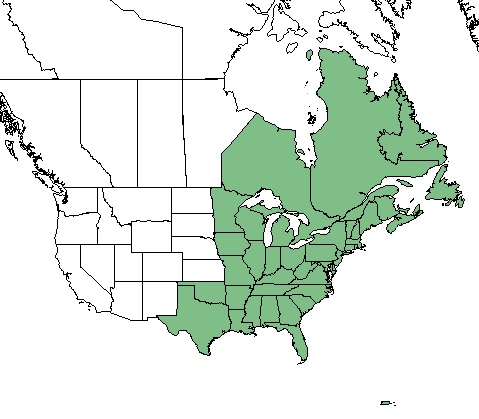Difference between revisions of "Osmundastrum cinnamomeum"
| Line 41: | Line 41: | ||
===Use by animals=== <!--Herbivory, granivory, insect hosting, etc.--> | ===Use by animals=== <!--Herbivory, granivory, insect hosting, etc.--> | ||
| − | In China, fronds from ''O. cinnamomeum'' are cooked in stir-fry type dishes and consumed by people.<ref name="Liu et al 2012">Liu Y, Wujisguleng W, Long C (2012) Food uses of ferns in China: A review. Acta Societatis Botanicorum Poloniae 81(4):263-270.</ref> The broad-winged hawk will collect sprigs for its nest of several plants and ferns, including ''O. cinnamomeum''. These sprigs are likely used to maintain a clean lining for the nestling.<ref name="Heinrich 2013">Heinrich B (2013) Why does a hawk build with green nesting material? Northeastern Naturalist 20(2):209-218.</ref> | + | In China, fronds from ''O. cinnamomeum'' are cooked in stir-fry type dishes and consumed by people.<ref name="Liu et al 2012">Liu Y, Wujisguleng W, Long C (2012) Food uses of ferns in China: A review. Acta Societatis Botanicorum Poloniae 81(4):263-270.</ref> White-tailed deer are also reported to consume the fern.<ref name="Atwood 1941">Atwood EL (1941) White-tailed deer foods of the United States. The Journal of Wildlife Management 5(3):314-332.</ref> The broad-winged hawk will collect sprigs for its nest of several plants and ferns, including ''O. cinnamomeum''. These sprigs are likely used to maintain a clean lining for the nestling.<ref name="Heinrich 2013">Heinrich B (2013) Why does a hawk build with green nesting material? Northeastern Naturalist 20(2):209-218.</ref> |
<!--==Diseases and parasites==--> | <!--==Diseases and parasites==--> | ||
Revision as of 20:31, 9 February 2018
| Osmundastrum cinnamomeum | |
|---|---|

| |
| Photo by John B hosted at Bluemelon.com/poaceae | |
| Scientific classification | |
| Kingdom: | Plantae |
| Division: | Pteridophyta – Ferns |
| Class: | Filicopsida |
| Order: | Polypodiales |
| Family: | Osmundaceae |
| Genus: | Osmundastrum |
| Species: | O. cinnamomeum |
| Binomial name | |
| Osmundastrum cinnamomeum L. | |

| |
| Natural range of Osmundastrum cinnamomeum from USDA NRCS Plants Database. | |
Common Name: cinnamon fern[1][2]
Contents
Taxonomic Notes
Synonyms: O. cinnamomea; O. cinnamomea var. cinnamomea; O. cinnamomea var. glandulosa;[1] Osmundastrum cinnamomeum[2]
Varieties: O. cinnamomeum var. cinnamomea; O. cinnamomeum var. glandulosa[1]
Description
Osmunda cinnamomea is a perennial fern that grows as a forb/herb.[2]
Distribution
This species can be found from Newfoundland and Labrador westward to Ontario and Minnesota, southward to southern Florida and central Texas. It is also in Mexico, southward through Central America to northern South America, in the West Indies, and in eastern Asia.[1]
Ecology
Habitat
O. cinnamomeum occurs in bogs, peatlands, pocosins, wet savannas, floodplains, blackwater stream swamps, and other wetlands.[1]
Phenology
In the southeastern and mid-Atlantic United States, O. cinnamomeum flowers from March through May.[1] On the Florida panhandle, reports of flowering are low and occur in April.[3]
Use by animals
In China, fronds from O. cinnamomeum are cooked in stir-fry type dishes and consumed by people.[4] White-tailed deer are also reported to consume the fern.[5] The broad-winged hawk will collect sprigs for its nest of several plants and ferns, including O. cinnamomeum. These sprigs are likely used to maintain a clean lining for the nestling.[6]
Conservation and Management
Cultivation and restoration
Photo Gallery
References and notes
- ↑ 1.0 1.1 1.2 1.3 1.4 1.5 Weakley AS (2015) Flora of the Southern and Mid-Atlantic States. Chapel Hill, NC: University of North Carolina Herbarium.
- ↑ 2.0 2.1 2.2 USDA NRCS (2016) The PLANTS Database (http://plants.usda.gov, 09 February 2018). National Plant Data Team, Greensboro, NC 27401-4901 USA.
- ↑ Nelson G (09 February 2018) PanFlora. Retrieved from gilnelson.com/PanFlora/
- ↑ Liu Y, Wujisguleng W, Long C (2012) Food uses of ferns in China: A review. Acta Societatis Botanicorum Poloniae 81(4):263-270.
- ↑ Atwood EL (1941) White-tailed deer foods of the United States. The Journal of Wildlife Management 5(3):314-332.
- ↑ Heinrich B (2013) Why does a hawk build with green nesting material? Northeastern Naturalist 20(2):209-218.